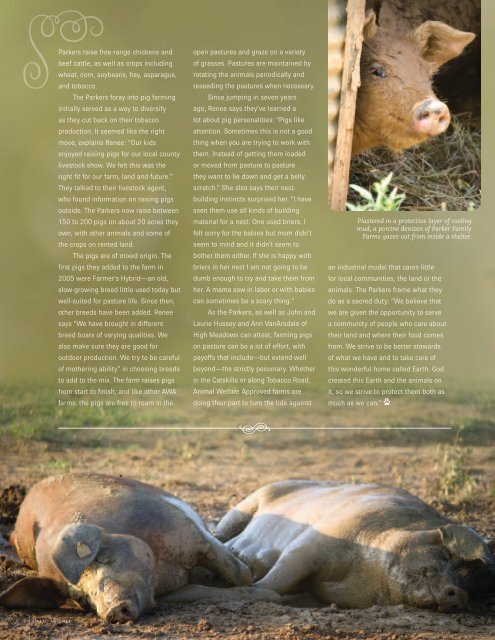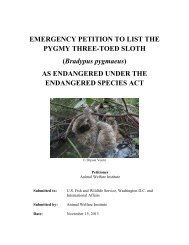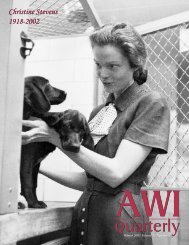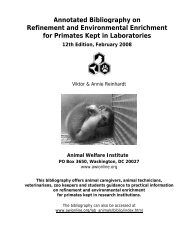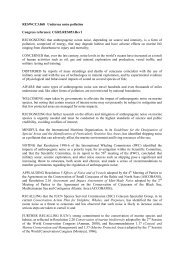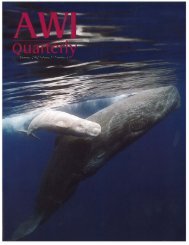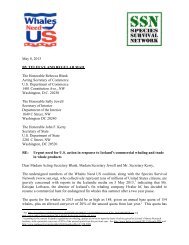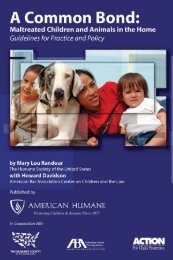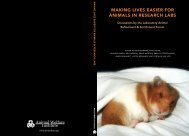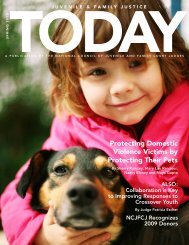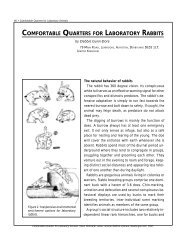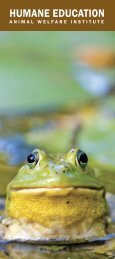Download - Animal Welfare Institute
Download - Animal Welfare Institute
Download - Animal Welfare Institute
You also want an ePaper? Increase the reach of your titles
YUMPU automatically turns print PDFs into web optimized ePapers that Google loves.
uParkers raise free-range chickens and<br />
beef cattle, as well as crops including<br />
wheat, corn, soybeans, hay, asparagus,<br />
and tobacco.<br />
The Parkers foray into pig farming<br />
initially served as a way to diversify<br />
as they cut back on their tobacco<br />
production. It seemed like the right<br />
move, explains Renee: “Our kids<br />
enjoyed raising pigs for our local county<br />
livestock show. We felt this was the<br />
right fit for our farm, land and future.”<br />
They talked to their livestock agent,<br />
who found information on raising pigs<br />
outside. The Parkers now raise between<br />
150 to 200 pigs on about 20 acres they<br />
own, with other animals and some of<br />
the crops on rented land.<br />
The pigs are of mixed origin. The<br />
first pigs they added to the farm in<br />
2005 were Farmer's Hybrid—an old,<br />
slow-growing breed little used today but<br />
well-suited for pasture life. Since then,<br />
other breeds have been added. Renee<br />
says “We have brought in different<br />
breed boars of varying qualities. We<br />
also make sure they are good for<br />
outdoor production. We try to be careful<br />
of mothering ability” in choosing breeds<br />
to add to the mix. The farm raises pigs<br />
from start to finish, and like other AWA<br />
farms, the pigs are free to roam in the<br />
open pastures and graze on a variety<br />
of grasses. Pastures are maintained by<br />
rotating the animals periodically and<br />
reseeding the pastures when necessary.<br />
Since jumping in seven years<br />
ago, Renee says they’ve learned a<br />
lot about pig personalities: “Pigs like<br />
attention. Sometimes this is not a good<br />
thing when you are trying to work with<br />
them. Instead of getting them loaded<br />
or moved from pasture to pasture<br />
they want to lie down and get a belly<br />
scratch.” She also says their nestbuilding<br />
instincts surprised her. “I have<br />
seen them use all kinds of building<br />
material for a nest. One used briers. I<br />
felt sorry for the babies but mom didn’t<br />
seem to mind and it didn’t seem to<br />
bother them either. If she is happy with<br />
briers in her nest I am not going to be<br />
dumb enough to try and take them from<br />
her. A mama sow in labor or with babies<br />
can sometimes be a scary thing.”<br />
As the Parkers, as well as John and<br />
Laurie Hussey and Ann VanArsdale of<br />
High Meadows can attest, farming pigs<br />
on pasture can be a lot of effort, with<br />
payoffs that include—but extend well<br />
beyond—the strictly pecuniary. Whether<br />
in the Catskills or along Tobacco Road,<br />
<strong>Animal</strong> <strong>Welfare</strong> Approved farms are<br />
doing their part to turn the tide against<br />
Plastered in a protective layer of cooling<br />
mud, a porcine denizen of Parker Family<br />
Farms gazes out from inside a shelter.<br />
an industrial model that cares little<br />
for local communities, the land or the<br />
animals. The Parkers frame what they<br />
do as a sacred duty: “We believe that<br />
we are given the opportunity to serve<br />
a community of people who care about<br />
their land and where their food comes<br />
from. We strive to be better stewards<br />
of what we have and to take care of<br />
this wonderful home called Earth. God<br />
created this Earth and the animals on<br />
it, so we strive to protect them both as<br />
much as we can.”<br />
8<br />
AWI Quarterly


